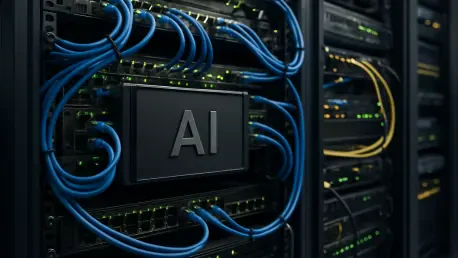As artificial intelligence (AI) integrates into the fabric of various industries and sectors, the role of supporting infrastructure becomes increasingly critical and transformational. No longer a mere futuristic concept, AI is now a foundational component driving innovation and operational efficiency across the globe. The infrastructure on which AI rests holds the key to unlocking its potential at scale, presenting both challenges and opportunities for organizations. Understanding the complexity and demands of AI deployment underscores the necessity for robust, adaptable, and state-of-the-art infrastructure that can seamlessly integrate the technology into existing systems. Gaining insights into how infrastructure can revolutionize AI deployment highlights its significance, transforming AI into a vital strategic asset in the modern technological era.
Burgeoning AI and Infrastructure Strain
The rapid adoption of AI places unprecedented demands on existing infrastructure, stretching capabilities beyond their original design. Traditional IT systems, once sufficient for business operations, now face challenges as AI solutions require extraordinary computing power, data processing, and storage capabilities. With organizations embedding diverse AI tools into daily functions, ranging from chatbots to intricate data models, there’s a substantial surge in resource requirements. Graphics Processing Units (GPUs), often highlighted for their role in AI tasks, are just a segment of the vast infrastructure ecosystem that’s imperative for effective AI integration. This ecosystem, encompassing expansive computing power, robust storage, and fast networking frameworks, must meet the speed, precision, and scalability demands that AI workloads necessitate.
The infrastructure strain is most evident in large-scale model training scenarios, necessitating thousands of GPUs and managing petabytes of data at immense speeds. Such tasks expose the limitations of traditional infrastructure, which wasn’t architected to manage resource-intensive AI functions efficiently. Organizations face the challenge of embedding AI without exponentially inflating operational costs or encountering efficiency setbacks. Data bandwidth constraints and latencies within data pipelines compound these challenges, making the need for infrastructure innovation even more pressing. Addressing these hurdles is essential for maintaining AI competitiveness and ensuring seamless integration within diverse operational frameworks.
Reimagining Infrastructure: AI-Native Approaches
To effectively cater to the demands of AI, there is a growing trend toward reimagining current infrastructure frameworks to create AI-native systems. These advanced architectures transcend traditional monolithic structures in favor of modular designs optimized for adaptability and scalability. Unlike their predecessors, modular systems allow for seamless growth in line with AI’s specific needs, offering organizations enhanced control over expenses and agility. This strategic transformation inherently supports AI’s dynamic nature, allowing infrastructures to adjust effortlessly to evolving workloads and technological requirements. The shift towards modularity enables businesses to augment capabilities incrementally, ensuring that resources align with precise operational needs.
Another stride in infrastructure transformation lies in the advancement of software-defined storage that parallels the efficacy and speed of conventional storage solutions while operating at reduced costs. This evolution in data management is key to supporting modern AI demands, ensuring swift data movement without incurring excessive financial burdens. Simultaneously, there is an increasing shift in AI deployment towards the edge. Industries like manufacturing and healthcare benefit from processing data closer to its source, resulting in reduced latency, improved data privacy, and diminished dependence on central data processing hubs. Bringing AI to the edge not only protects sensitive information but also enhances operational efficiencies across various sectors, forming a cornerstone of contemporary infrastructure strategies.
Sovereign AI and Governance Challenges
The infrastructure landscape is also deeply influenced by geopolitical factors, as nations aim to cultivate “Sovereign AI” systems that ensure technological independence. This nationalistic strategy underscores the desire for domestically developed AI infrastructures free from foreign biases or external control. As part of this trend, countries across continents are investing in local data centers and related infrastructures, engaging in significant model training initiatives within their borders. By doing so, they aim to nurture AI capabilities that honor local cultural norms and values, fostering technological autonomy and security. These movements not only elevate technological self-reliance but also instigate substantial growth in domestic AI expertise and resources.
Furthermore, as AI becomes integral to essential sectors like healthcare, defense, and finance, robust governance becomes paramount. Trust and accountability in AI systems are crucial, urging infrastructures to support comprehensive traceability of AI model lineage, from data sources to deployment histories. This traceability is indispensable, transforming from a valuable benefit to an absolute necessity for ensuring the transparency and integrity of AI systems. By facilitating effective governance, infrastructures enable organizations to maintain accountability, thereby fostering trust and confidence among users and stakeholders as AI adoption intensifies across critical domains.
Strategic Asset for Future Readiness
The swift integration of AI is putting immense pressure on current infrastructure, pushing capacities beyond their intended limits. Traditional IT setups, which once met operational needs, are now challenged by AI systems that demand immense computing power, enhanced data processing, and substantial storage. With organizations incorporating AI tools into daily functions—from chatbots to complex data models—there’s a noticeable increase in resource demand. While Graphics Processing Units (GPUs) are often noted for AI tasks, they’re merely one part of a vast infrastructure network crucial for seamless AI integration. This network, requiring massive computational power, sturdy storage, and fast networking, must meet AI’s demanding speed, accuracy, and scalability needs. The pressure is particularly visible in large-scale training models, requiring numerous GPUs and managing huge data volumes swiftly, exposing traditional infrastructure’s inadequacies meant for less demanding tasks. Overcoming these challenges is crucial for staying competitive in AI and ensuring smooth integration into various operational areas.









